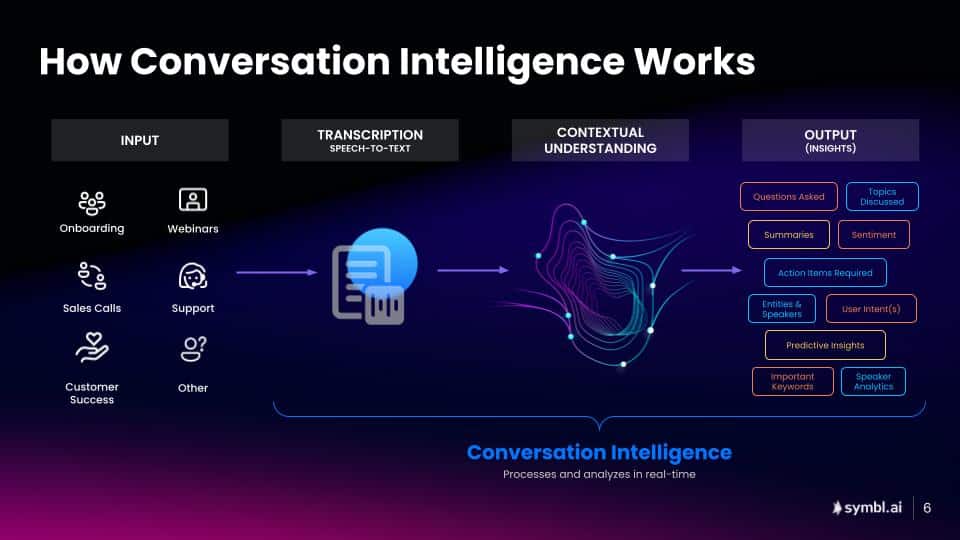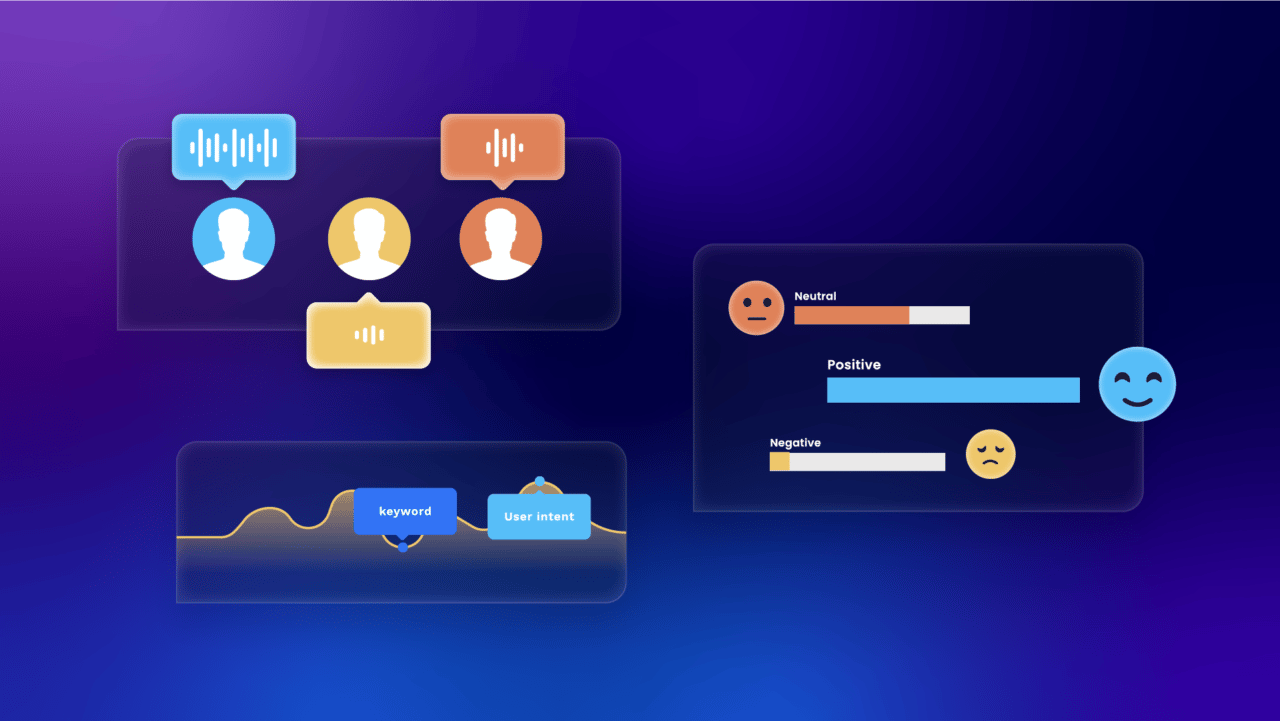Hello all and welcome to the wild world of data analysis—I’m Niall Ridgley, and I’ll be your guide.
My qualifications? Well, I’ve spent the last year-and-a-half writing SEO-informed content about all things data/text/sentiment analysis, and I’ve just joined the Symbl.ai team as a technical writer. I’ll be making it my personal mission to keep any readers interested in these topics informed, engaged, and hopefully even entertained.
I think the best and most honest place to start would be my reason for joining Symbl to begin with—a belief in our platform’s potential.
It’s a relief and a privilege to actually be excited about the product you’re writing about. I personally believe that Symbl.ai can and should become a household name for any and all businesses hoping to keep up among the chaos of the modern online marketplace.
Machine learning-backed feedback analysis is the way of the future, and Symbl.ai’s platform and power just make sense. Or, well, they do to me. Let me try and convince you, too.
The best way to explain what I found most intriguing and awe-inspiring about Symbl.ai is to unpack the difference between conversation intelligence and conversation analysis, and in doing so demonstrate what separates Symbl.ai from other feedback analysis options.
I hope that doing so piques your curiosity as it did mine.
The end goal here is to demonstrate how the application of new, artificial intelligence-powered techniques can improve your conversation analytics.
We’ll speed through two key definitions, then look at three practical applications, touching on key acronyms along the way (as is tradition in tech). Throughout I’ve aimed to keep the definitions clear and the real time low. Let’s get into the weeds.
1. What Is Conversation Analysis?
Conversation analysis can be whatever you want it to be.
Just kidding. That was a test to see who is paying attention. I’ll try to keep these definitions easy, quick, and clear so you can be on your way.
Conversation analysis is the process of breaking down voice data to study the differences between speakers and what they are talking about.
Businesses use conversation analysis to determine the intent and interest level of each speaker. These insights are then used to predict desires, and, in turn, boost overall customer satisfaction.
Improved satisfaction, when leveraged correctly, can help you provide better customer experience (CX). Better CX can do double duty—firstly, it can entice new customers, and, even more invaluably, decrease churn. Churn reduction just means you are more likely to retain your existing customers.
Impact-wise, CX is king. In recent years survey data has demonstrated that good customer experience is the No. 1 brand differentiator, with 1 in 3 customers leaving a brand after a single bad interaction.
Here’s a quick look at the results of polling 1,500 businesses about what their highest short term business priority is:
Image credit: SuperOffice
As you can see, feedback analysis has a massive impact on any business’s bottom line and conversation analysis is a crucial cog in this process. Conversation analysis’ main function is to listen to your customers and correctly interpret their desires. This ensures great feedback analysis, leading to excellent CX and increased customer loyalty down the line.
With all that at stake, it’s the little things in your customer analytics that can make all the difference. So, let’s take a look at how.
2. What Is Conversation Intelligence?
Conversation intelligence is the process of using automated technology to more effectively analyze business interactions.
That’s the dry, rote definition. Essentially, conversation intelligence is the difference that effective, accurate artificial intelligence can make in your feedback analysis efforts
Intelligent analysis can help you take control of your feedback process from end-to-end and inform your efforts through the power of AI.

To give you some context on how this works, let’s run through three examples, each applied to a different subprocess of “classic” conversation analytics:
The three common tools that we’ll look at (used by analytics, refined by intelligence) are:
- Keyword extraction
- Topic summarization
- Sentiment analysis
2a. Keyword Extraction
Keyword extraction is the flagging of key terms and the tallying of their number of uses.
Intelligent analysis improves this process by flagging each keyword in context and tied to sentiment for added dept of insight
Analytics: ‘The bug was not good. The gray bug, however, was great’
Intelligent Analytics: ‘The bug was not good. The gray bug, however, was great’
Here, “bug” is a separate term from “gray bug.” As you can see, if your approach isn’t sophisticated (“intelligent”) enough it fails to flag the difference between “bug” and “gray bug” and you end up misinterpreting the meaning.
2b. Topic Summarization
Topic summarization is the distillation and separation of different topics within a conversation so that each topic can be analyzed further.
Great, intelligent analysis engines make sure accuracy is maintained at all levels. Part of this is using in-house or well-paired transcriptions software:
Analytics: “My self own service cut out around two lakes.”
Intelligent Analytics: “My cell phone service cut out around Two Lakes.”
While it may seem like a small deal, sophisticated AI that understands the speaker by applying context (grammar, “self own” vs “cell phone”) and uses provided personal information (PI) about the customer to know that Two Lakes is a nearby town to the speaker can be the difference between a complete misinterpretation and a nuanced understanding of the conversation.
2c. Sentiment Analysis
Sentiment analysis is the natural language processing (NLP) procedure that determines whether data is negative, positive, or neutral, then groups it accordingly for data analysis.
In conversation analytics, this simply means figuring out how each speaker feels about each topic.
Crucially, intelligent analysis uses speaker diarization to tell the difference between multiple speakers based on cadence, pitch and other factors. Check out the difference this makes:
Analytics: “I like the jacket. Yeah the jacket is cool. I wish it had pockets, though. I don’t mind.”
Intelligent Analytics: “I like the jacket. Yeah the jacket is cool. I wish it had pockets though. I don’t mind.”
Speakers don’t always declare themselves, so being able to tell who is talking based on vocal patterns rather than words is key. As you can see in the above example, the speakers differ in their opinion about the pockets—this product feature insight would have been missed if the speakers weren’t correctly identified based on more than just their words alone.
3. TL;DR – Parting Words
Customer experience (CX) might be king, but context above all else is key to understanding your customers, and in turn making your CX top-of-the-line.
Conversation intelligence is conversation analytics done right—it emphasized accuracy above all else, ensuring a clean process and actionable, effective results.
When you consider how complicated and nuanced language is, accuracy can make the difference between your product and CX teams going in the right direction versus going on an unnecessary (and likely expensive) wild goose chase.
Making the right decisions at the source ensures good results down the line; quality in, quality out.
Hey—that’s a pretty good mantra. I’ll try to apply that more. Look out for more content from me; I’m looking forward to seeing you around.
– Niall
For more in-depth information on how conversation intelligence works, and how it can help you, check out our blog, our features list, or, for the more technically minded, our documentation library for developers.
